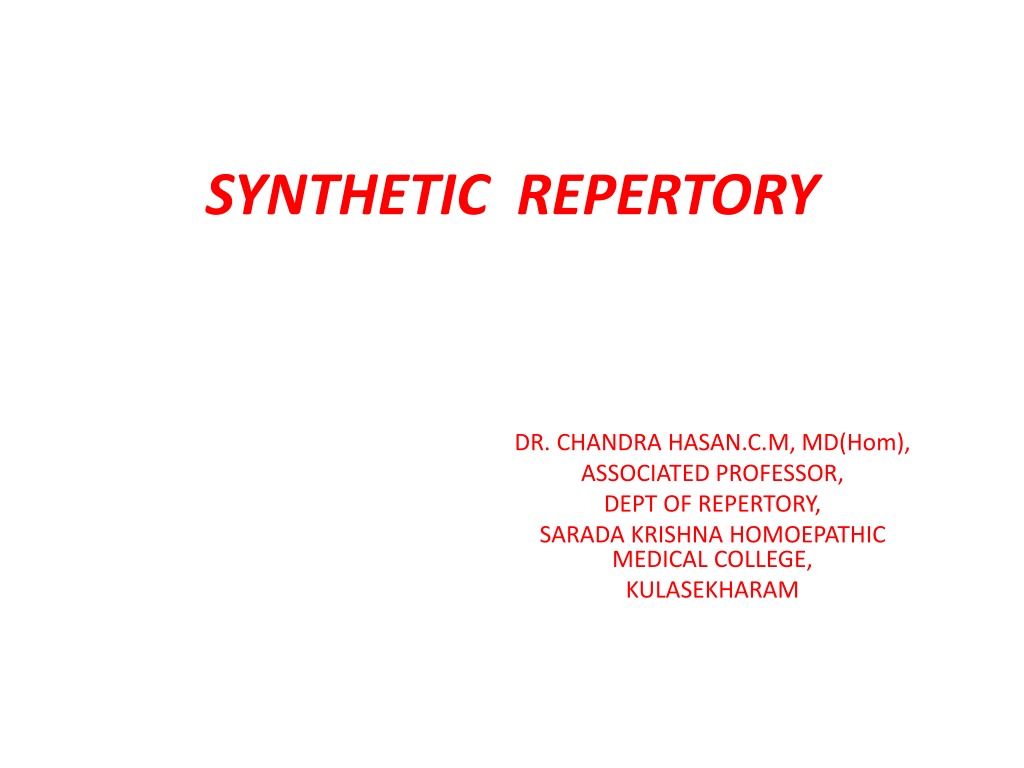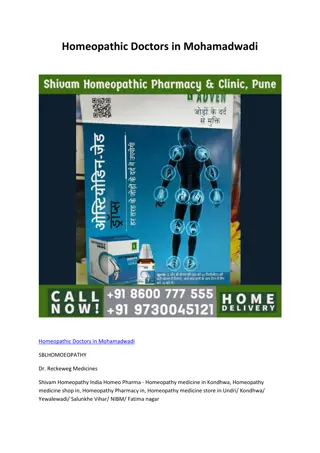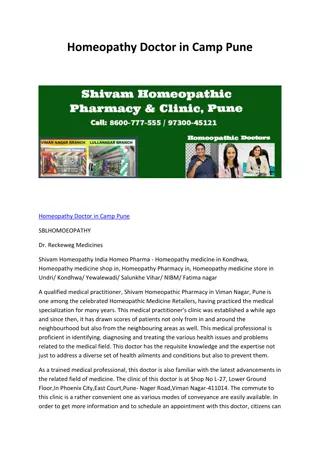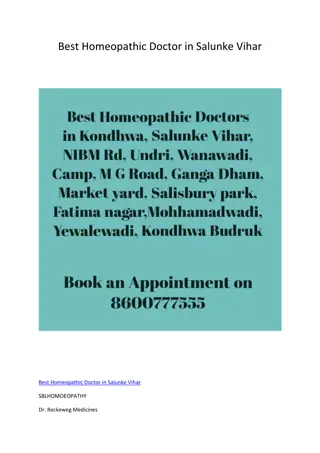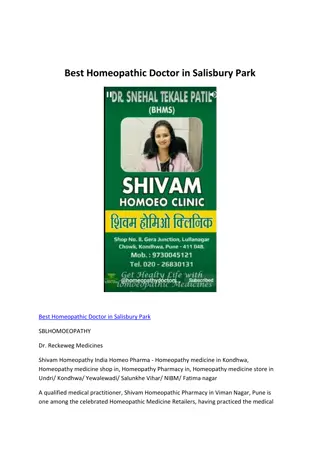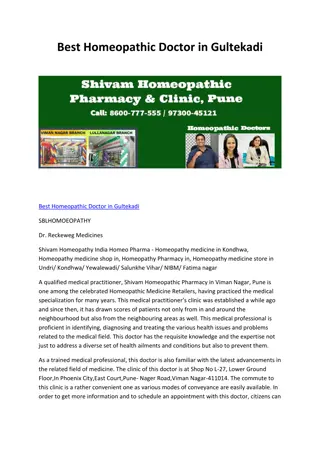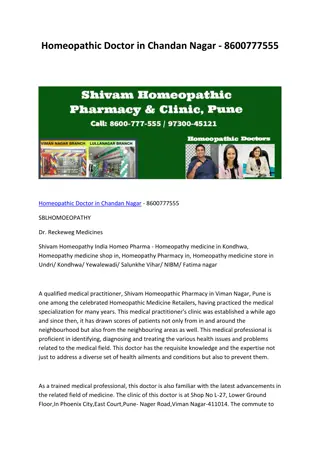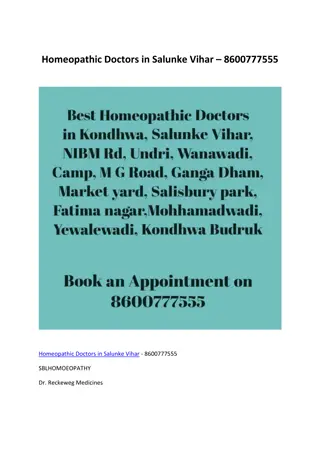Comprehensive Overview of Synthetic Repertory in Homeopathy
Dr. Chandra Hasan, along with Dr. Barthel and Dr. Klunker, developed the Synthetic Repertory as an extension of Kent's repertory, addressing lacunae and incorporating data from various reliable sources. The repertory focuses on general symptoms for chronic cases, with significant contributions from multiple authors and sources in homeopathy.
Download Presentation

Please find below an Image/Link to download the presentation.
The content on the website is provided AS IS for your information and personal use only. It may not be sold, licensed, or shared on other websites without obtaining consent from the author. Download presentation by click this link. If you encounter any issues during the download, it is possible that the publisher has removed the file from their server.
E N D
Presentation Transcript
SYNTHETIC REPERTORY DR. CHANDRA HASAN.C.M, MD(Hom), ASSOCIATED PROFESSOR, DEPT OF REPERTORY, SARADA KRISHNA HOMOEPATHIC MEDICAL COLLEGE, KULASEKHARAM
SYNTHETIC REPERTORY (putting together) Authors : Dr. Med. Horst Barthel (vol :I and II ) Dr. Med. Will Klunker. (vol : III ) Editions : First edition 1973 Second revised and improved edition : 1982 Third edition : 1987 (published in India) Forth improved reprint edition :1993 History : Many practitioners have found some lacunae while referring to kent s repertory, because of that Dr.Boger and Dr.Vithoulkas made significant additions to Kent s repertory and both published their works under the same title, Additions to Kent s repertory.
Dr. Barthel and Dr. Klunker again improved the Kent s repertory , collected datas from various relaiable sources and published them in the form of synthetic repertory. This new work is basically an extension of Kent s repertory The title Synthetic repertory was the result of three fold synthesis. a, Supplement from the oldest to the latest Homoeopathic literature. b, Register of equalents and related symptoms. c, Composition of individual subjects, (ex) complaints due to psychic trauma. The general symptoms are used for the choice of
the similimum especially in chronic cases. So the repertory is limited to only general symptoms Sources of the repertory : 1, J.T.Kent s repertory, lectures on Homoeopathic materia medica, new remedies. 2, Calvin B Knerr, repertory of Hering s guiding symptoms. 3, Bonneinghausen s, Boger Boenninghausen s repertories, boger s additions to Kent s repertory,Boger s synaptic key. 4. Jahr, G.H.G, Systematic alphabetic repertory of Homoeopathic remedy doctrine. 5,Gallavardin. J.P. The repertory and the materia medica from psychisme et Homoeopathic.
6, Stauffer, K., Symptom index. 7, Schmidt.P., The supplements by 35 authors to his four repertories of Kent have been integrally included, also Groupment Hahnemannian de lyon was used. 8, Boericke, O.E, Materia medica and repertory of W. Boericke. 9, Stephenson. J. drug proving. 10, Mezger. J., The symptoms of 35 reproven new drugs have been taken from selected homoeopathic materia medica 11. Allen. T.F.,Encyclopedia of pure materia medica, a general symptom register of homoeopathic materia medica.
12, Clark. J.H., A clinical repertory, repertory to the dictionary of materia medica. 13, Various journals containing recent durg provings. 14, Julian. O.A., Materia medica de homoeopathic, dictionaier de matiere medicate de 130. Noveaux homoeotherapeutique. 15Kunzil. J. Supplements taken from inter national homoeopathic literature. 16, Hahnemann.S. pure materia medica, chronic disease. Philosophical back ground : The repertory is based on generals, because the author is providing importance to general symptoms. The logic behind is didective logic.
Plan and construction : According to the hierarchy of general symptoms synthic repertory is divided in to three volumes Volume I : Mental generals. Volume :II : Physical generals (except sleep and dreams and sexual symptoms). Volume .III : Sleep and dreams male and female sexual symptoms. Each volume contain preface at first, in the preface author mentioned about difficulties in translating this book. Then gratitude to the persons those who contributed and helped. Next in each volume introduction is mentioned. Under this sources of synthetic repertory are mentioned, and structure of the repertory is mentioned.
After that bibliography mentioned, then remedies and their abbreviations alphabetically, next part is repertory proper, at the end word index is mentioned ( in volume I and II) limited to synonyms and cross references. Gradations : Grade one : Small roman letters : ars Grade two : Small bold letters : ars Grade three : Bold capital letters : ARS Grade four : Bold capital letters underlined : ARS (ex) ;AILMENTS FROM : Anger, Indignation, with : ars, aur; COLOC.,
ip., lyc., merc., mur-ac, nat-mur, nux-v., plat., STAPH. Total number of medicines in first edition 1573, in the second edition 1594. Each page of the repertory is divided in to two using a vertical line. Arrangement of the rubrics : The main rubrics and sub rubrics are arranged in alphabetical order in each volumes under chapters. Main rubrics are in bold capital letters, sub rubrics are small bold letters, but times of day, clock times, other headings are in ordinary letters. The synthetic repertory mentions for the first time the exact sources of symptoms or drugs added to Kent s repertory, and use a numbering system. Symptoms and drugs from Kent s original repertory have not been numbered. Additions made
by Kent in his own hand are marked 1, supplements from his lectures and new remedies by 1., 2 to 16 coincide with the enumeration of the above mentioned sources. According to Pierre Schmidt, his and Gallaverdin s experiences justify classification of certain drugs of Kent in to higher grades. These durgs are marked by both figures as 1.5 or 1.7. The contents of the Kent s final general repertory are included in the first edition of synthetic repertory In some publications where three languages are used, the rubrics at first written in English, then French, then German. The abbreviations agg and am have been used in all languages to mean the modalities aggravation and
amelioration respectively. In English index is limited to synonyms and cross references (in volume I and II). Symptoms with asterics means it is one of the new rubric collected.( volume I and II contains 138 new rubrics). (ex), AILMENTS from bad news* Volume I, consist of mental symptoms arranged in alphabetical order, pattern of arrangement in each rubric is, rubric in general, cross references, time, sub-rubrics pertaining to that rubric in alphabetic order.
Volume II, starts with TIME : day time, morning, forenoon, noon, afternoon, evening and night, with specific time modalities under each rubric. Alphabetically arranged GENERAL RUBRICS pertaining to state of person, in that rubric FOOD and DRINGS consist of aggravation, ailments from, amelioration, aversion and desire. PAIN rubrics starts with pain ailments from, appearance of pain like comes suddenly, disappears slowly, etc., then direction, time, location, type of pain. Clinical rubrics like, arteriosclerosis, sarcoma, hyper tension, hypo tension, Hodgkin's disease, multiple sclerosis, T.B. prophylaxis, etc. General rubrics pain with different types, pulse
type. Children affections of biting nails, putting finger in the mouth, growing too fast, etc. Volume III, sleep, dreams, sex-male, and sex-female, rubrics are arranged under each section with rubric in general, time, rubric pertaining to that alphabetically. The obsolete drugs like, electricitas, galvanism, magnetis artificialis and ophiotoxicum were not retained. Double entries, lack of clarity, and wrong nomenclature, were corrected wherever possible. Concept of totality : Concept of totality is based on Kent s concept of totality. The main importance is given to generals only. The concept that generals are the expressions
of the constitution of a person has been given significance in constructing totality. The prominent generals at mental and physical levels form the basis of totality in whole case. The repertorisation is done by, using only mental general symptoms , using only physical general symptoms and using mental general and physical general symptoms. If the case is having characteristic particular symptoms along with general symptoms, the author permits the use of Kent s repertory for the repertorisation of particular symptoms.
Special features : 1, It consist of only general symptoms much more and thus help full for repertorisation where lot of general symptoms are present. 2, Causative mental symptoms are brought together under one rubric called Ailments from in volume I. 3, Desire, aversion, aggravation, and amelioration from particular food are kept under one heading called food and drinks, in volume II. 4, It consist of 1594 remedies and many more rubrics. 5, Sources from where the symptoms and drugs are taken are properly indicated by numbers.
6, Huge reference : old, new, rare and specific references are possible. 7,Helps in studying materia medica. 8, Some publications are published in three languages. 9, Common errors like double entries, lack of clarity, and wrong nomenclatures are corrected. 10, Obsolete drugs like , electricitas, galvanism, magnetis artificialis, complex snake drug ophitoxicum are not retained. 11, Many clinical rubrics are mentioned in this repertory. 12, Time modalities are well arranged and represented.
Criticism or demerits : 1, Mental causative ailments are separated, but physical causative ailments are scattered in Volume II 2, Appetite rubric is not their in this repertory. 3, This repertory is not use full for the cases which have particular symptoms. 4, The author advocates caution regarding : Verification of drugs, possible mistakes in sources, mistakes over looked by authors. 5, Number of rubrics in sleep, female sex and male sexual chapters are very less 6, Though it is enlarged version of Kent s repertory, in mind chapter 18 rubrics are missing.
7, The repertory contain three volumes and the authors instructing physicians to use Kent s repertory for particular symptoms, so it is not easy for a quick bed side reference. 8, Some of the medicines used in this repertory are not available in common materia medica books. Hence knowledge about these medicines remain incomplete.
New rubrics in synthetic repertory, are not in Kents : mind rubrics : Adulterous. Alert Affability Agility mental Ailments from Anorexia mentalis
Bargaining Bilious disposition Buoyancy Corrupt Country desire for Finance aptitude for Pessimist Postponing Selflessness Yielding disposition Unreliable Undignified Tearing Susceptibility Rubrics not in synthetic repertory but in Kent s : ATTITUDES, assumes BELLOWING FRIGHT, complaints from GROWLING like a dog KNEELING and praying MANIA A POTU MIRTH, hilarity, liveliness, catch NEW, objects seems PIETY, nocturnal POWER, love of REPULSIVE MOOD SEXUAL EXCESS, mental symptoms from SURPRISES, pleasant, affections after
UNFRIENDLY, humor UNOBSERVING UNREAL UNTRUTHFUL WICKED, disposition WILD feeling New rubrics added related to food : Alcohol agg Apple agg Ale agg Aromatic drinks agg Butter milk agg Ice agg Ice cream agg Lemonade amel Meat amel New rubrics added in sleep chapter. Affected sleep before menses Anxious Coma vigil Confused Dreamless Dull Exhausting Light Pains sleep during Sleep day time by night sleeplessness.
New dreams related rubrics added : Adventurous Air attacks Amputation of arm Ball Base ball Bees Beggars Blood Blood shed Building Desert New main and sub rubrics added in male genitalia : Ejaculation : insensible Ejaculation : short Ejaculation : increased Erection : exhausted Handles genitalia when coughing Sexual aversion Sexual desire diminished with erection Desire increased sleep during Sterility Voluptuous sensations
Few main and sub rubrics added in female genitalia : Abortion 1st month Abortion with anaemia Abortion from syphilis Leucorrhoea in children Leucorrhoea syphilitic Menses injury after Sexual aversion Placenta previa Sepsispuerperai Sexual desire increased during parturition. Clinical rubrics : volume I Anorexia Catalepsy Catatonia Cretinism Delirium Delirium tremens Mania-a- potu/Dementia Hysteria Idiocy Imbecility Mania Schizophrenia catatonic hebephrenic paranoid. Volume II Agranulocytosis Anaemia pernicious Apoplexy Aviator s disease Basedow s disease
Cancerous affections epithelioma lupus, carcinomatous melanoma Catalepsy Chlorosis Convulsions Death, apparent : asphyxia neonatorum, in asphexia of. Elephantiasis Emaciation children in Marasmus Glanders Gonorrhoea, suppressed Haemorrhage blood- non coagulable, haemophilia Hodgkin s disease Hypertension Hypotension Inflammations blood vessels of arteritis - phlebitis, milk leg bones of osteitis osteomylitis periosteum of periosteitis bursae of, bursitis cartilage of, chondritis cellulitis chronic appendicitis hepatitis ovaries of - prostatitis
sinusitis tonsilitis glands of, adenitis joints of, arthritis arthritis deformance lymphangitis muscles of, myositis nerves of, neuritis Lymphogranulomatosis serous membranes of synovitis tendons, tendinitis Injuries concussion dislocation, luxation sprains, dislocations bones of, fractures compound fractures stump neuralgia Leukaemia Measles,after exanthema repelled Myotrophy, progressive spinal Myxoedema Paralysis agitans Landry's ascending paralysis poliomyelitis post-diphtheriticus spastic spinal paralysis, Rickets, Sarcoma, Scarlet fever, after exanthema repelled, Sclerosis, multiple, Septicemia, blood poisoning, Tuberculosis, lupus vulgaris,
Tumour- angioma, fungus, haematode, haemangioma, - atheroma, straetoma encephaloma enchondroma erectile fibroid ganglion keloid, cheloid lipoma nervus noma osteoma papilloma, Varicose vein, ulceration, Whooping cough, ailments after, Volume III Abortion, Atonia (inertia) uteri, Infantilismus genitalis, Leucorrhoea, Metrorrhagia, Placenta praevia. Important rubrics mentioned in synthetic repertory : Volume I (main rubrics are in capital letters) Abrupt, Absent minded, Absorbed, Abstraction of mind, Abusive, Activity, Affectation, Affectionate,
Ailments from, Amativeness, Ambition, Amorous, Anger, Anguish, Anorexia mentalis, Answers, Anticipation, Antics-plays, Anxiety, Audasity, Avarice, Aversion, Brooding, Business, Busy, Capriciousness, Cares, Carried, Cautious, Censorious, Chaotic, Cheerfull, Clairvoyance, Company aversion, Company desire, Concentration, Confidence, Confusion, Conscientious, Consolation, Contemptuous, Contradiction, Conversation, Courageous, Cowardice, Cretinism, Cruelty, Cursing, Dancing, Death-agony, Delirium, Delirium tremens, Delusions, Dementia, Despair, Destructiveness, Dipsomania, Discomfort, Discouraged, Disgust, Dream, Dullness, Eccentricity, Egotism, Envy, Excitement, Exertion, Exhilaration,
Fancies, Fear, Foolish, Forgetful, Forsaken, Frightened, Gestures, Grief, Homesickness, Hopeful, Hurry, Hydrophobia, Hypochondriasis, Hysteria, Ideas, Imbecility, Impatience, Indifference, Indolence, Industrious, Insanity, Introspection, Irresolute, Irritability, Jealous, Jesting, Kill, Kleptomania, Lamenting, Lascivious, Laughing, Libertinism, Loathing, Loquacity, Malicious, Mania, Memory, Memory weakness of, Mildness, Misanthropy, Mischievous, Moaning, Mocking, Monomania, Mood, Moral, Music, Nymphomania, Obstinate, Optimistic, Pessimist, Prostration, Quarrelsome, Rage, Remorse, Restlessness, Sadness, Schizophrenia
Sensitive, Shamelessness, Sighing, Singing, Slowness, Somnambulism, Spoken to, Staring, Stupefaction, Suicidal, Sympathy, Talking, Thoughts, Timidity, Tranquility, Travel, Trifles, Unconsciousness, Violent, Vivacious, Weary of life, Weeping, Wildness, Witty, Work, Yielding.
